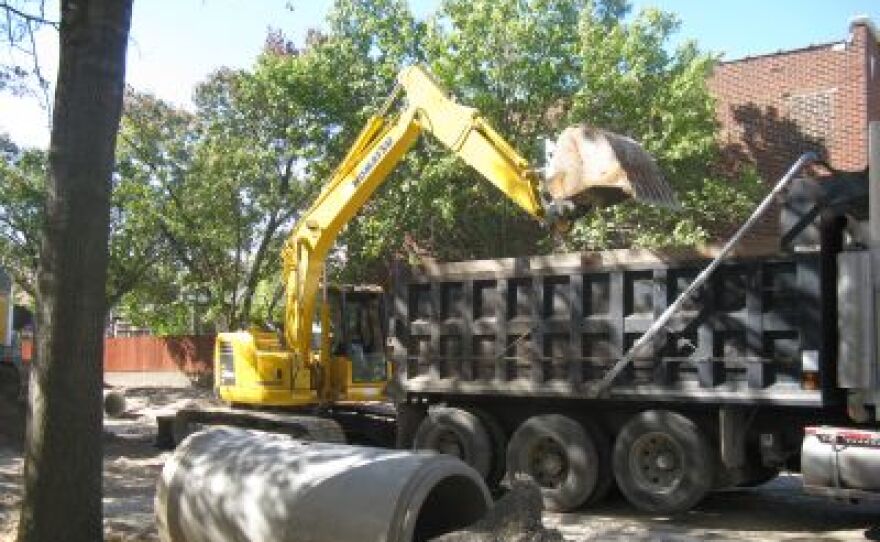http://stream.publicbroadcasting.net/production/mp3/national/local-national-993709.mp3
The Metropolitan St. Louis Sewer District has resolved a lawsuit with the Environmental Protection Agency with promises to fix its aging system.
But the consent decree, which still must be signed off on by a federal judge, comes with a huge price tag, an estimated $4.7 billion over 23 years.
In the second of a two-part series on the overhaul of the sewer district, St. Louis Public Radio’s Maria Altman explains MSD’s rate payers will be picking up the tab.
Updating infrastructure under pressure
In the Tower Grove neighborhood in south St. Louis backhoes and skid loaders have become a familiar sight and sound.
Workers are putting in new pipes and storm drains.
It’s part of an effort by MSD to eliminate basement backups, which plague this neighborhood during heavy rain storms.
The district has been trying to update its infrastructure in recent years, but now MSD is under pressure to do so more quickly.
An agreement with the EPA reached this summer sets hard deadlines for MSD to meet federal Clean Water regulations at a likely cost of $4.7 billion.
“It’s the 21st century. Having sewage in creeks that flows through people’s backyards. That’s not where we want to be,” said Jeff Theerman, MSD’s executive director.
He says the decree can be seen in a positive light.
“Yes, it’s a court enforceable agreement, but it’s something that needs to be done.”
Theerman has the unenviable task of explaining to customers that they’ll be shouldering almost all of that $4.7 billion cost.
This summer and fall MSD held public hearings on the first proposed rate increase.
The district says it needs to invest $1 billion in capital from 2013 to 2016. To do that MSD wants to issue $945 million in bonds, as well as implementing a four-year rate increase.
Officials explained the average household bill would rise from $28 today to about $47 by July of 2015. That’s if voters agree the district can issue bonds. Otherwise rates could shoot up to about $73 by 2013.
Why fix the problems now?
At a public hearing in north St. Louis in August, city resident Sharon Sharp echoed many of the comments when she asked “why now?”
“Our sewer system is old. It’s been old a long, long time,” Sharp said. “So now all at once you want to fix the sewer, but people cannot afford it. Even working people cannot afford these constant increases.”
MSD does provide assistance for low and fixed-income residents.
But Sharp is not alone in questioning why it’s taken MSD so long to address its infrastructure, parts of which are 150 years old.
Long-time MSD critic Tom Sullivan says the district failed to act long after the Clean Water Act was passed in 1972.
“They’ve been late getting around to meeting the requirements and the thing of it is, back in those times the federal government picked up just about 90 percent,” Sullivan said. “So the fact that they drug their feet for so many years, ratepayers are going to be paying a lot more than they should.”
MSD says it sought all the federal dollars it could.
But the district’s officials readily admit that rates were kept too low through the 1970s, and 80s and later when they did try to raise rates they were met with lawsuits.
Then in the late 1990s MSD changed its charter to create a 15-member rate commission and give the district the ability to issue bonds and begin to address environmental problems.
It efforts to catch up didn’t satisfy the EPA.
Finding a solution
Rate Commission chairman Len Toenjes isn’t interested in pointing fingers.
He’s the chairman of the rate commission, which makes recommendations to MSD’s Board of Trustees after taking public comment.
This time the commission is suggesting MSD get slightly less than what it’s asking of rate payers.
But even if the Board of Trustees agrees, the difference is minimal - $43 a month for the average household versus $47.
Toenjes says there is no easy way to meet EPA’s requirements.
“It’s a balancing act,” he said. “Everybody is going to feel a little pain in this.”
The proposal will go to MSD’s Board of Trustees next month and then onto voters who will decide whether to allow the district to issue bonds.
It’s not going to end there, though.
MSD estimates to meet the EPA’s consent decree the average household’s bill could eventually rise to $80 a month.




